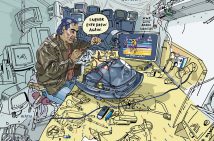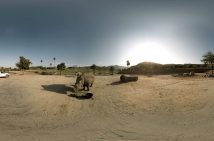Submarine Channel

Is Immersive Content the Future of Journalism? II
Is Immersive Content the Future of Journalism? II
Can immersive content represent a viable business model for journalism? This is the main question that guides our exploration of the way innovative newsrooms are starting to employ new storytelling formats like VR, AR, and all other R’s. For the second part of this mini-series, we talked to two women that work for two major media outlets: Maria Fernanda Lauret from Al Jazeera and Francesca Panetta from The Guardian.
by Davide Banis
Maria Fernanda Lauret (Al Jazeera):
Even more than VR, what excites me at the moment is the potential of volumetric videos
Maria Fernanda Lauret is in charge of post-production at Contrast VR, the media lab of Al Jazeera that produces immersive content mainly in the form of 360 videos and virtual reality. I reached out to her over Skype to find out more about her work. I was in Amsterdam while she was in Doha, where Al-Jazeera is based.
Let’s start with a hackneyed question: what’s the future of journalism?
I believe that immersive content will surely be part of the winning blend. And I’m not just referring to VR or AR. Actually, what really excites me at the moment is the potential of volumetric videos. We’re still at an early stage but it’s something that we want to explore.
Having said that, I can’t assure you what the future of journalism is, but I can tell you that VR, AR and MR will increasingly be able to provide experiences to broader audiences in a way that pushes journalism further than any other medium has so far been able to do.
What’s so great about them?
Well, volumetric video is a new technology still in development that allows viewers to walk around the scene and interact with the environment. This would be just an advancement giving the viewer more agency and sense of reality.
You said that you’re still at an early stage. What kind of problems are you facing? Technical?
Although there are still plenty of technical limitations, the industry is evolving and technology is quickly advancing. However, tech aside, in our mission to make immersive content more palatable for journalism, we face a whole array of other issues. For example, we’re still educating the public that journalism is not just about reading or watching the news anymore. Now they have a chance to experience someone’s story on a deeper level, to go to a different country and be immersed in a completely different culture and situations they wouldn’t be able to experience otherwise. Having access to these kinds of stories through immersive virtual reality turns the issues we cover a lot more personal and interesting for whoever is watching.
You produce a lot of 360 videos. What’s the main challenge with them?
I would say that the main challenge that a lot of publishers face with 360 videos is how to translate the quality of experience of an immersive technology for a larger audience. Virtual reality is best watched on a headset, but we all know that most people do not have that readily available, so we have to think about how to get people to have a good experience on alternative platforms, like watching 360 videos on mobile and desktop on Facebook or YouTube.
In doing so, you have to make sure your audience is educated on what 360 video is. Further, since the immersive quality is less pronounced than if the 360 video was being viewed in a headset, the challenge is to make sure that the medium still adds value to the story. We combat this by making sure to provide dynamic and visually compelling stories that immediately draw the audience in within seconds of the story. Once we pull the viewer in within those first crucial few seconds, we rely on excellent storytelling that utilizes the 360 video space in order to make our stories as immersive as possible. On our social platforms, we publish a 360 video once a week, covering a variety of content from all over the world.
Ok, let’s tackle the main question: how do you monetize immersive content?
So far, we’ve mostly financed it through partnerships with high-profile organizations, like Amnesty International and World Vision. In any case, we always retain total editorial control. In a near future, we’d like to produce premium content just for subscribers. But you need a strong core audience for that.
What’s one technique that you used for a project at Contrast VR and you thought: “Oh, this really adds a layer of depth that you can’t have in traditional journalism”?
I might surprise you but I’d say animation. We used it for a piece about an oil spill that happened in Nigeria, for example. On one side of the screen, you could see footage of the landscape after the disaster, while, on the other, you could see an animated reconstruction of how the same landscape used to be in the past. It really added an aesthetic component that was not possible to have with real images.
Francesca Panetta (The Guardian):
At The Guardian, VR is financed in the same way of traditional journalism
Some weeks before my interview with Maria Fernanda, I had the opportunity to meet Francesca Panetta, whose job title is nothing less than “executive director for VR” at The Guardian. We sat in a corner of a crowded Amsterdam bar and started our conversation discussing the contribution of VR to journalism. What does it bring?
What do you think VR can represent for journalism?
VR can give you an embodied experience. For example, it can put you in a place you couldn’t be otherwise. Also, I think it gets really interesting when VR allows you to put yourself in someone else’s shoes. It can be a baby or an asylum seeker. In this sense, VR has a fictional potential. I like the term “storyliving” to describe this kind of embodiment that VR can grant.
Still, it seems that VR lacks a solid audience. High-end devices are expensive and people – after they experienced the thrill of the novelty – often don’t show much interest in watching VR projects on a regular basis.
Well, that’s because VR is still an experimental form of storytelling. I don’t like predictions but tech is going to move on and, of course, we’ll have different devices. Our mobile phones will be different, maybe more VR-friendly. It always takes a while for a new medium to establish its conventions and become popular.
How can you make money out of a VR piece?
The industry is still figuring out ways to monetize VR. It’s tricky and still early days.
It seems that VR content is not easier to monetize than traditional journalism. Actually, major organizations like The Guardian and Al Jazeera finance immersive journalism in the same way they finance all their other content. As Maria Fernanda Lauret and Francesca Panetta highlighted, this includes sponsorships, subscriptions, and voluntary donations.
Does this mean that immersive content can’t provide a viable business model for journalism? It seems the case. Or maybe we just need to approach the matter from a different perspective. That’s what we’ll try to do in the latest part of this mini-series.
The case against video: The Industry
Maria Fernanda Lauret mentioned that there are things that you simply can’t do with video footage. Mirka Duijn thought the same when she directed The Industry, an interactive documentary about the Dutch (illegal) drug industry. Co-produced by Submarine Channel and Dutch broadcaster VPRO. Instead of video, she used 3D models to create immersive scenes that users can navigate freely without being constrained to a single point of view, that is the main problem of VR projects according to both Lauret and Duijn.
—
This article is the second installment in a new series that investigates whether immersive content (virtual and augmented Realities, world-building,…) could constitute a viable business model for the future of journalism.
Is Immersive Storytelling the Future of Journalism (Part I)
Is Immersive Storytelling the Future of Journalism (Part II)
Is Immersive Storytelling the Future of Journalism (Part III)









